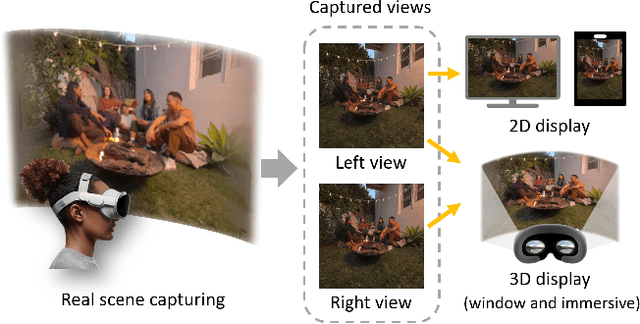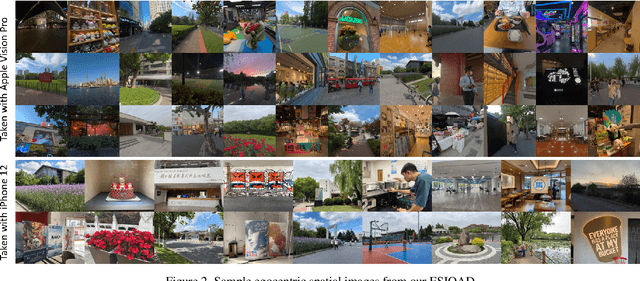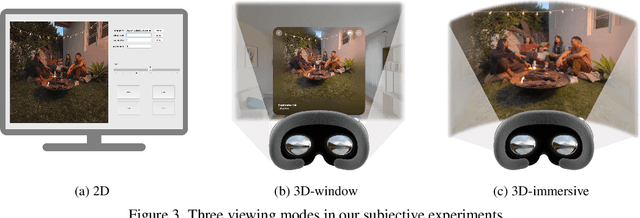Huiyu Duan
Multi-Dimensional Quality Assessment for Text-to-3D Assets: Dataset and Model
Feb 24, 2025Abstract:Recent advancements in text-to-image (T2I) generation have spurred the development of text-to-3D asset (T23DA) generation, leveraging pretrained 2D text-to-image diffusion models for text-to-3D asset synthesis. Despite the growing popularity of text-to-3D asset generation, its evaluation has not been well considered and studied. However, given the significant quality discrepancies among various text-to-3D assets, there is a pressing need for quality assessment models aligned with human subjective judgments. To tackle this challenge, we conduct a comprehensive study to explore the T23DA quality assessment (T23DAQA) problem in this work from both subjective and objective perspectives. Given the absence of corresponding databases, we first establish the largest text-to-3D asset quality assessment database to date, termed the AIGC-T23DAQA database. This database encompasses 969 validated 3D assets generated from 170 prompts via 6 popular text-to-3D asset generation models, and corresponding subjective quality ratings for these assets from the perspectives of quality, authenticity, and text-asset correspondence, respectively. Subsequently, we establish a comprehensive benchmark based on the AIGC-T23DAQA database, and devise an effective T23DAQA model to evaluate the generated 3D assets from the aforementioned three perspectives, respectively.
Facial Attractiveness Prediction in Live Streaming: A New Benchmark and Multi-modal Method
Jan 05, 2025



Abstract:Facial attractiveness prediction (FAP) has long been an important computer vision task, which could be widely applied in live streaming for facial retouching, content recommendation, etc. However, previous FAP datasets are either small, closed-source, or lack diversity. Moreover, the corresponding FAP models exhibit limited generalization and adaptation ability. To overcome these limitations, in this paper we present LiveBeauty, the first large-scale live-specific FAP dataset, in a more challenging application scenario, i.e., live streaming. 10,000 face images are collected from a live streaming platform directly, with 200,000 corresponding attractiveness annotations obtained from a well-devised subjective experiment, making LiveBeauty the largest open-access FAP dataset in the challenging live scenario. Furthermore, a multi-modal FAP method is proposed to measure the facial attractiveness in live streaming. Specifically, we first extract holistic facial prior knowledge and multi-modal aesthetic semantic features via a Personalized Attractiveness Prior Module (PAPM) and a Multi-modal Attractiveness Encoder Module (MAEM), respectively, then integrate the extracted features through a Cross-Modal Fusion Module (CMFM). Extensive experiments conducted on both LiveBeauty and other open-source FAP datasets demonstrate that our proposed method achieves state-of-the-art performance. Dataset will be available soon.
HarmonyIQA: Pioneering Benchmark and Model for Image Harmonization Quality Assessment
Jan 02, 2025



Abstract:Image composition involves extracting a foreground object from one image and pasting it into another image through Image harmonization algorithms (IHAs), which aim to adjust the appearance of the foreground object to better match the background. Existing image quality assessment (IQA) methods may fail to align with human visual preference on image harmonization due to the insensitivity to minor color or light inconsistency. To address the issue and facilitate the advancement of IHAs, we introduce the first Image Quality Assessment Database for image Harmony evaluation (HarmonyIQAD), which consists of 1,350 harmonized images generated by 9 different IHAs, and the corresponding human visual preference scores. Based on this database, we propose a Harmony Image Quality Assessment (HarmonyIQA), to predict human visual preference for harmonized images. Extensive experiments show that HarmonyIQA achieves state-of-the-art performance on human visual preference evaluation for harmonized images, and also achieves competing results on traditional IQA tasks. Furthermore, cross-dataset evaluation also shows that HarmonyIQA exhibits better generalization ability than self-supervised learning-based IQA methods. Both HarmonyIQAD and HarmonyIQA will be made publicly available upon paper publication.
ESVQA: Perceptual Quality Assessment of Egocentric Spatial Videos
Dec 29, 2024



Abstract:With the rapid development of eXtended Reality (XR), egocentric spatial shooting and display technologies have further enhanced immersion and engagement for users. Assessing the quality of experience (QoE) of egocentric spatial videos is crucial to ensure a high-quality viewing experience. However, the corresponding research is still lacking. In this paper, we use the embodied experience to highlight this more immersive experience and study the new problem, i.e., embodied perceptual quality assessment for egocentric spatial videos. Specifically, we introduce the first Egocentric Spatial Video Quality Assessment Database (ESVQAD), which comprises 600 egocentric spatial videos and their mean opinion scores (MOSs). Furthermore, we propose a novel multi-dimensional binocular feature fusion model, termed ESVQAnet, which integrates binocular spatial, motion, and semantic features to predict the perceptual quality. Experimental results demonstrate the ESVQAnet outperforms 16 state-of-the-art VQA models on the embodied perceptual quality assessment task, and exhibits strong generalization capability on traditional VQA tasks. The database and codes will be released upon the publication.
FineVQ: Fine-Grained User Generated Content Video Quality Assessment
Dec 26, 2024



Abstract:The rapid growth of user-generated content (UGC) videos has produced an urgent need for effective video quality assessment (VQA) algorithms to monitor video quality and guide optimization and recommendation procedures. However, current VQA models generally only give an overall rating for a UGC video, which lacks fine-grained labels for serving video processing and recommendation applications. To address the challenges and promote the development of UGC videos, we establish the first large-scale Fine-grained Video quality assessment Database, termed FineVD, which comprises 6104 UGC videos with fine-grained quality scores and descriptions across multiple dimensions. Based on this database, we propose a Fine-grained Video Quality assessment (FineVQ) model to learn the fine-grained quality of UGC videos, with the capabilities of quality rating, quality scoring, and quality attribution. Extensive experimental results demonstrate that our proposed FineVQ can produce fine-grained video-quality results and achieve state-of-the-art performance on FineVD and other commonly used UGC-VQA datasets. Both Both FineVD and FineVQ will be made publicly available.
F-Bench: Rethinking Human Preference Evaluation Metrics for Benchmarking Face Generation, Customization, and Restoration
Dec 17, 2024Abstract:Artificial intelligence generative models exhibit remarkable capabilities in content creation, particularly in face image generation, customization, and restoration. However, current AI-generated faces (AIGFs) often fall short of human preferences due to unique distortions, unrealistic details, and unexpected identity shifts, underscoring the need for a comprehensive quality evaluation framework for AIGFs. To address this need, we introduce FaceQ, a large-scale, comprehensive database of AI-generated Face images with fine-grained Quality annotations reflecting human preferences. The FaceQ database comprises 12,255 images generated by 29 models across three tasks: (1) face generation, (2) face customization, and (3) face restoration. It includes 32,742 mean opinion scores (MOSs) from 180 annotators, assessed across multiple dimensions: quality, authenticity, identity (ID) fidelity, and text-image correspondence. Using the FaceQ database, we establish F-Bench, a benchmark for comparing and evaluating face generation, customization, and restoration models, highlighting strengths and weaknesses across various prompts and evaluation dimensions. Additionally, we assess the performance of existing image quality assessment (IQA), face quality assessment (FQA), AI-generated content image quality assessment (AIGCIQA), and preference evaluation metrics, manifesting that these standard metrics are relatively ineffective in evaluating authenticity, ID fidelity, and text-image correspondence. The FaceQ database will be publicly available upon publication.
AIGV-Assessor: Benchmarking and Evaluating the Perceptual Quality of Text-to-Video Generation with LMM
Nov 26, 2024



Abstract:The rapid advancement of large multimodal models (LMMs) has led to the rapid expansion of artificial intelligence generated videos (AIGVs), which highlights the pressing need for effective video quality assessment (VQA) models designed specifically for AIGVs. Current VQA models generally fall short in accurately assessing the perceptual quality of AIGVs due to the presence of unique distortions, such as unrealistic objects, unnatural movements, or inconsistent visual elements. To address this challenge, we first present AIGVQA-DB, a large-scale dataset comprising 36,576 AIGVs generated by 15 advanced text-to-video models using 1,048 diverse prompts. With these AIGVs, a systematic annotation pipeline including scoring and ranking processes is devised, which collects 370k expert ratings to date. Based on AIGVQA-DB, we further introduce AIGV-Assessor, a novel VQA model that leverages spatiotemporal features and LMM frameworks to capture the intricate quality attributes of AIGVs, thereby accurately predicting precise video quality scores and video pair preferences. Through comprehensive experiments on both AIGVQA-DB and existing AIGV databases, AIGV-Assessor demonstrates state-of-the-art performance, significantly surpassing existing scoring or evaluation methods in terms of multiple perceptual quality dimensions.
MMHead: Towards Fine-grained Multi-modal 3D Facial Animation
Oct 10, 2024



Abstract:3D facial animation has attracted considerable attention due to its extensive applications in the multimedia field. Audio-driven 3D facial animation has been widely explored with promising results. However, multi-modal 3D facial animation, especially text-guided 3D facial animation is rarely explored due to the lack of multi-modal 3D facial animation dataset. To fill this gap, we first construct a large-scale multi-modal 3D facial animation dataset, MMHead, which consists of 49 hours of 3D facial motion sequences, speech audios, and rich hierarchical text annotations. Each text annotation contains abstract action and emotion descriptions, fine-grained facial and head movements (i.e., expression and head pose) descriptions, and three possible scenarios that may cause such emotion. Concretely, we integrate five public 2D portrait video datasets, and propose an automatic pipeline to 1) reconstruct 3D facial motion sequences from monocular videos; and 2) obtain hierarchical text annotations with the help of AU detection and ChatGPT. Based on the MMHead dataset, we establish benchmarks for two new tasks: text-induced 3D talking head animation and text-to-3D facial motion generation. Moreover, a simple but efficient VQ-VAE-based method named MM2Face is proposed to unify the multi-modal information and generate diverse and plausible 3D facial motions, which achieves competitive results on both benchmarks. Extensive experiments and comprehensive analysis demonstrate the significant potential of our dataset and benchmarks in promoting the development of multi-modal 3D facial animation.
How Does Audio Influence Visual Attention in Omnidirectional Videos? Database and Model
Aug 10, 2024



Abstract:Understanding and predicting viewer attention in omnidirectional videos (ODVs) is crucial for enhancing user engagement in virtual and augmented reality applications. Although both audio and visual modalities are essential for saliency prediction in ODVs, the joint exploitation of these two modalities has been limited, primarily due to the absence of large-scale audio-visual saliency databases and comprehensive analyses. This paper comprehensively investigates audio-visual attention in ODVs from both subjective and objective perspectives. Specifically, we first introduce a new audio-visual saliency database for omnidirectional videos, termed AVS-ODV database, containing 162 ODVs and corresponding eye movement data collected from 60 subjects under three audio modes including mute, mono, and ambisonics. Based on the constructed AVS-ODV database, we perform an in-depth analysis of how audio influences visual attention in ODVs. To advance the research on audio-visual saliency prediction for ODVs, we further establish a new benchmark based on the AVS-ODV database by testing numerous state-of-the-art saliency models, including visual-only models and audio-visual models. In addition, given the limitations of current models, we propose an innovative omnidirectional audio-visual saliency prediction network (OmniAVS), which is built based on the U-Net architecture, and hierarchically fuses audio and visual features from the multimodal aligned embedding space. Extensive experimental results demonstrate that the proposed OmniAVS model outperforms other state-of-the-art models on both ODV AVS prediction and traditional AVS predcition tasks. The AVS-ODV database and OmniAVS model will be released to facilitate future research.
ESIQA: Perceptual Quality Assessment of Vision-Pro-based Egocentric Spatial Images
Jul 31, 2024



Abstract:With the development of eXtended Reality (XR), head-mounted shooting and display technology have experienced significant advancement and gained considerable attention. Egocentric spatial images and videos are emerging as a compelling form of stereoscopic XR content. Different from traditional 2D images, egocentric spatial images present challenges for perceptual quality assessment due to their special shooting, processing methods, and stereoscopic characteristics. However, the corresponding image quality assessment (IQA) research for egocentric spatial images is still lacking. In this paper, we establish the Egocentric Spatial Images Quality Assessment Database (ESIQAD), the first IQA database dedicated for egocentric spatial images as far as we know. Our ESIQAD includes 500 egocentric spatial images, containing 400 images captured with the Apple Vision Pro and 100 images generated via an iPhone's "Spatial Camera" app. The corresponding mean opinion scores (MOSs) are collected under three viewing modes, including 2D display, 3D-window display, and 3D-immersive display. Furthermore, based on our database, we conduct a benchmark experiment and evaluate the performance of 22 state-of-the-art IQA models under three different viewing modes. We hope this research can facilitate future IQA research on egocentric spatial images. The database is available at https://github.com/IntMeGroup/ESIQA.
 Add to Chrome
Add to Chrome Add to Firefox
Add to Firefox Add to Edge
Add to Edge